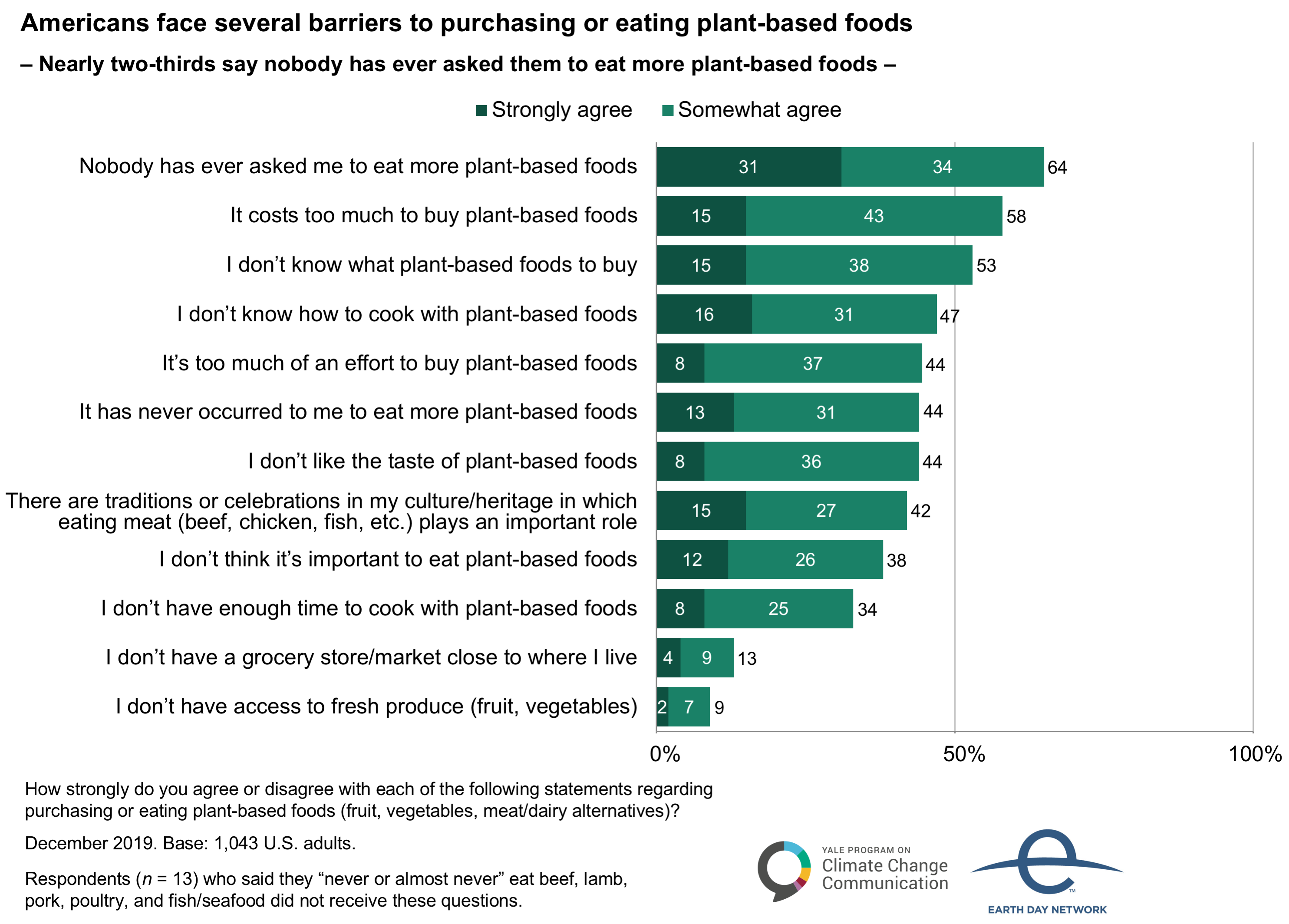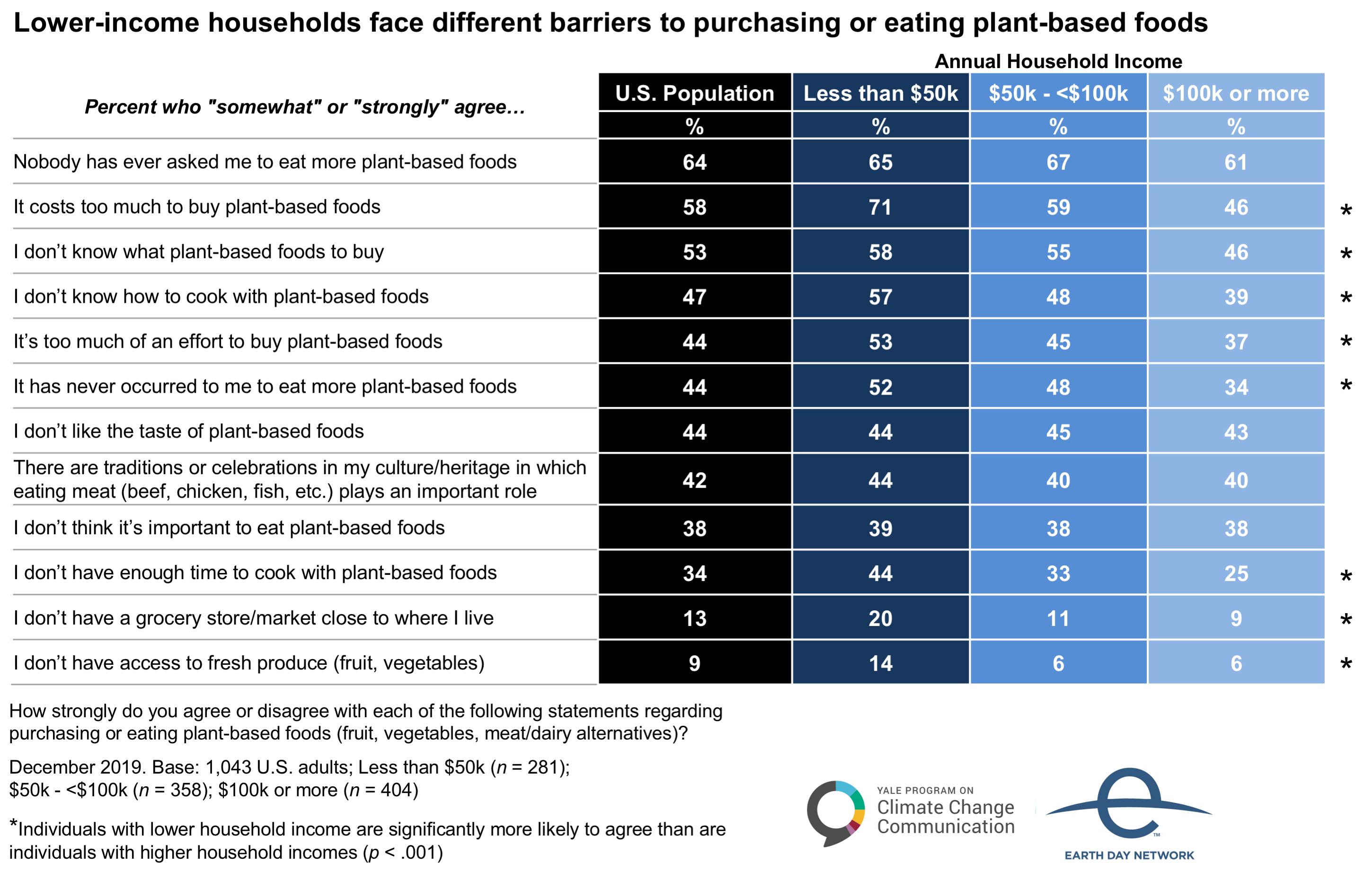Report · Feb 13, 2020
Climate Change and the American Diet
By Anthony Leiserowitz, Matthew Ballew, Seth Rosenthal and Jillian Semaan
3. Barriers to Purchasing and Eating Plant-Based Foods
3.1. Americans face several barriers to purchasing or eating plant-based foods.
Many Americans face barriers to purchasing or eating plant-based foods, including structural, financial, informational, or psychological barriers. About one in eight Americans (13%) say they don’t have a grocery store/market close to where they live, and 9% say they don’t have access to fresh produce (fruit, vegetables).
Other barriers are more common. Nearly two-thirds of Americans (64%) say nobody has ever asked them to eat more plant-based foods, and more than half say that it costs too much to buy plant-based foods (58%) and/or that they don’t know what plant-based foods to buy (53%).
Additionally, four in ten or more Americans say they don’t know how to cook with plant-based foods (47%), that it’s too much of an effort to buy plant-based foods (44%), that it has never occurred to them to eat more plant-based foods (44%), that they don’t like the taste of plant-based foods (44%), and/or that there are traditions or celebrations in their culture/heritage in which eating meat plays an important role (42%). Nearly four in ten say they don’t think it is important to eat plant-based foods (38%), and 34% say they don’t have enough time to cook with plant-based foods.
3.2. Lower-income households face different barriers to purchasing or eating plant-based foods.
According to the United States Department of Agriculture (USDA), about 11% of households in the U.S. were food-insecure at least at some point during 2018, meaning that they were unable to access or were uncertain of having enough food for a healthy diet for all household members.https://www.ers.usda.gov/topics/food-nutrition-assistance/food-security-in-the-us/key-statistics-graphics/ Lower-income households had higher rates of food insecurity compared to the national average.
On average, Americans with an annual household income of less than $50,000 are more likely than are Americans with higher household incomes to experience several barriers to purchasing or eating plant-based foods. Lower-income Americans are more likely to say they lack access to a nearby grocery store/market (20%) compared to middle- (11%) and higher-income Americans (9%). Lower-income Americans are also more likely to say they lack access to fresh produce (14% vs. 6% of both middle- and higher-income Americans), that it is too much of an effort to buy plant-based foods (53% vs. 45% of middle- and 37% of higher-income Americans), and/or that it costs too much to buy plant-based foods (71% vs. 59% of middle- and 46% of higher-income Americans).
A greater proportion of lower-income Americans also say they don’t know what plant-based foods to buy (58% vs. 55% of middle- and 46% of higher-income Americans), don’t know how to cook with plant-based foods (57% vs. 48% of middle- and 39% of higher-income Americans), and/or don’t have enough time to cook with plant-based foods (44% vs. 33% of middle- and 25% of higher-income Americans). About half of lower- (52%) and middle-income (48%) Americans say it has never occurred to them to eat more plant-based foods, compared to 34% of those with higher incomes.
3.3. About half of Americans think a meal with a plant-based main course is more expensive than a meal with a meat-based main course.
According to the United States Department of Agriculture (USDA), the estimated price of foods depends on how cost is measured, such as the price per calorie or price per edible weight.https://www.ers.usda.gov/webdocs/publications/44678/19980_eib96.pdf?v=42321 When measured by the edible weight or average portion size of the food, on average, fruit, vegetables, and grains are less expensive than most meat-based foods (e.g., beef, pork, chicken).
About half of Americans (49%) think a meal with a plant-based main course (fruit, vegetables, meat/dairy alternatives) is more expensive than a meal with a meat-based main course (beef, chicken, fish, etc.). In contrast, only about one in seven Americans (14%) think a meal with a plant-based main course is less expensive than a meal with a meat-based main course. About one in five Americans (22%) think the two cost about the same, and 15% say they don’t know.
About half of lower-income Americans (earning a household income of less than $50,000 annually) and middle-income Americans (earning between $50,000 and $99,999) think a meal with a plant-based main course is more expensive than a meal with a meat-based main course (53% and 52%, respectively), while higher-income Americans (earning more than $100,000) are less likely to think so (42%; see Appendix I, p. 30).


